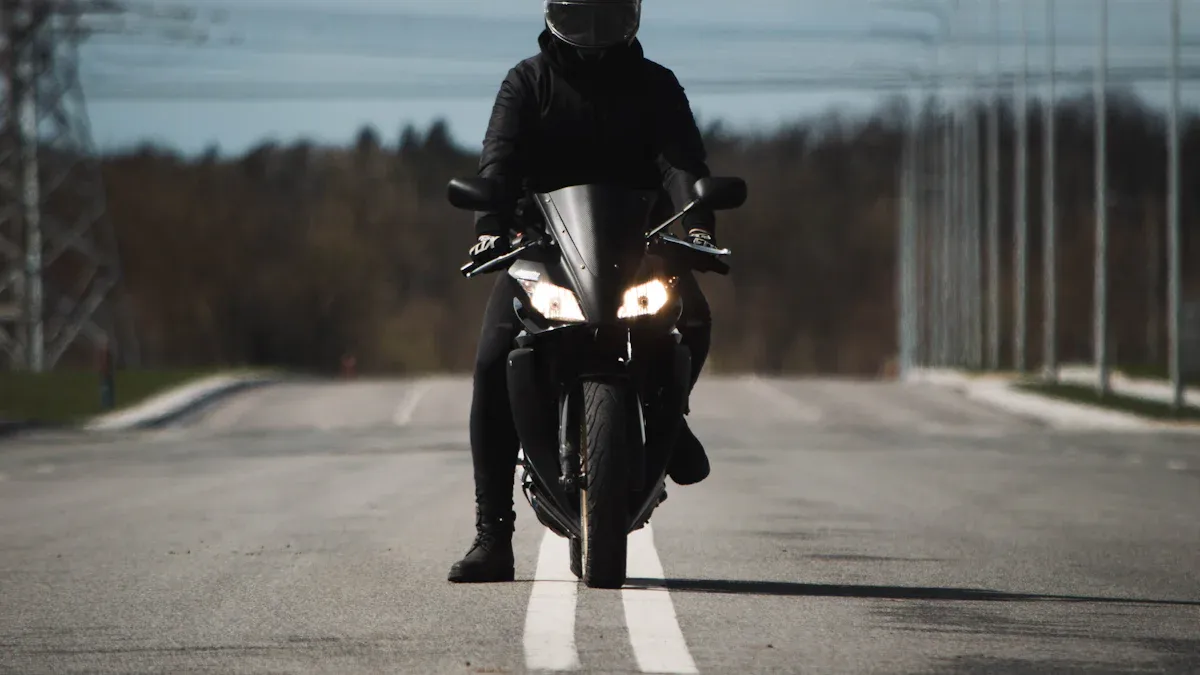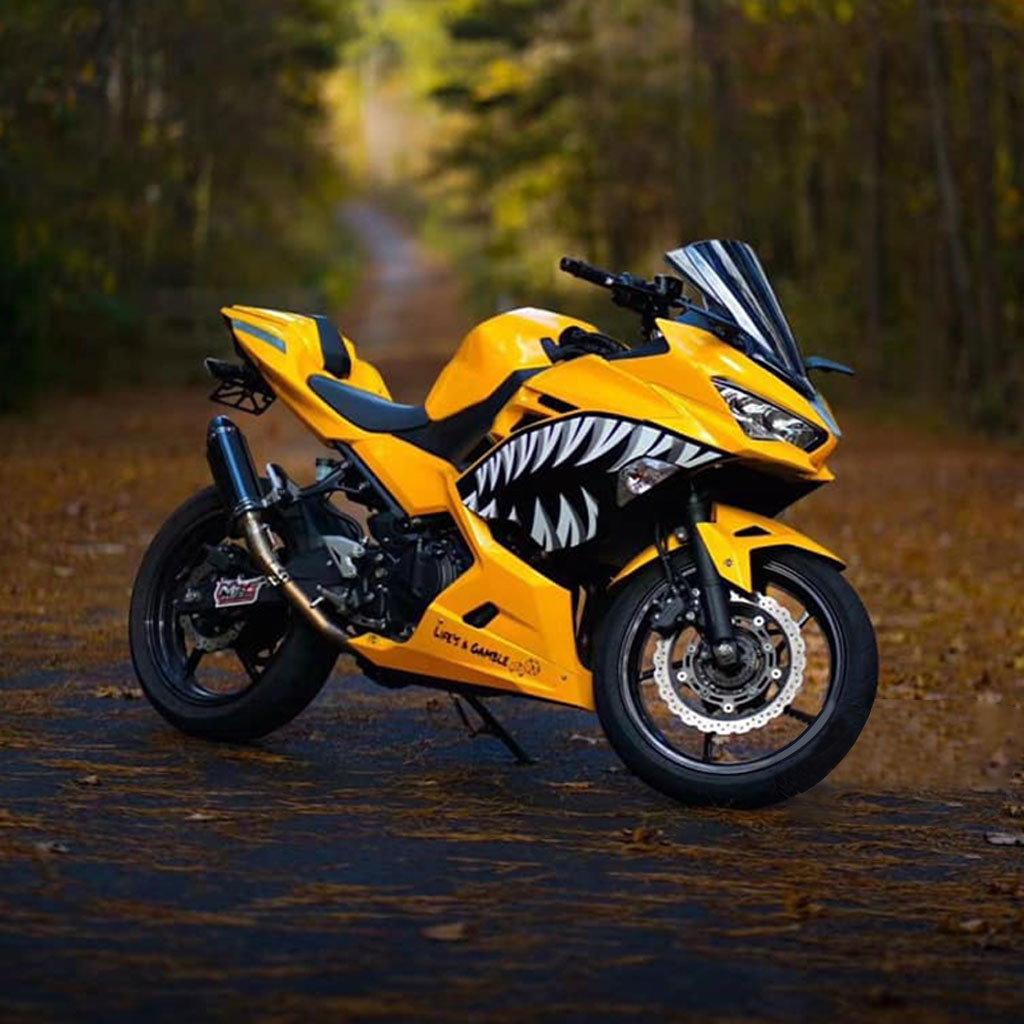Essential Gear for Sportbike Riders: Safety Meets Style

When you hit the road on a sportbike, safety and style go hand in hand. Wearing essential gear not only shields you from injuries but also enhances your riding experience. Did you know helmets saved 1,872 lives in 2015 alone? Investing in high-quality gear, like jackets and boots, is a must for every rider.
Key Takeaways
Always wear a good helmet. Full-face helmets protect best, lowering head injury risk by 69%.
Buy jackets and pants with armor. They guard against scrapes and crashes while looking cool.
Pick gloves that help with safety and grip. Full-finger gloves shield hands and give better control, even when it's wet.
Helmets: The Basics of Staying Safe
Helmets are the most important gear for sportbike riders. They don’t just protect your head—they also boost comfort and confidence. Picking the right helmet can improve your riding experience a lot. Let’s explore the types and find what suits you best.
Full-Face Helmets: Best for Safety and Speed
Full-face helmets give the most protection for your head and chin. They cover everything, making them the safest choice in accidents. Studies show they lower head injury risk by 69% and death risk by 37%.
Did you know 34.6% of crash impacts hit the chin? Full-face helmets protect this area well.
These helmets are also great for riding fast. Their smooth design cuts through wind, making your ride easier. Whether you’re in the city or on the highway, full-face helmets keep you safe and comfortable.
Helmet Type | Protection Level |
|---|---|
Full-Face Helmet | Best protection for head and chin |
Open-Face Helmet | Less protection, chin left uncovered |
Modular Helmets: Flexible and Practical
Modular helmets are a mix of full-face and open-face designs. You can flip up the chin part to talk or take a break.
Helmet Type | Features | Best For |
|---|---|---|
Flip-up Modular | Works as full-face or open-face, has sun visors, anti-fog features | City riders, long-distance riders |
Dual-sport Modular | Tough design, extra chin protection, good for both road and dirt riding | Adventure riders |
These helmets are great for city riders and travelers. They often include helpful features like anti-fog systems and sun visors. While not as protective as full-face helmets, they’re a good choice for riders who want options.
Open-Face Helmets: Light and Stylish

Open-face helmets are all about comfort and style. They don’t cover your chin, so they’re lighter and easier to wear for long rides. If you like a retro look or casual rides, these helmets are perfect.
Open-face helmets are popular for their classic style and lightweight feel.
They reduce neck strain, making them great for long trips.
Even though they don’t protect as much as full-face helmets, they’re still a favorite for riders who value comfort and looks. Add goggles for better vision and extra safety.
Protective Apparel: Jackets and Pants for Safety and Style
Riding jackets and pants are not just for looks. They protect you from scrapes, crashes, and bad weather. Picking the right gear keeps you safe and stylish on your bike.
Armored Jackets: Safety Meets Comfort and Style
Every rider needs an armored jacket. These jackets protect you during accidents while keeping you comfortable. Good jackets have CE-certified armor on shoulders, elbows, and back to absorb shocks.
"I wore my LS2 FF386 Modular Helmet and Cramster Eclipse Jacket with CE armor. These gears saved me and let me walk away safely."
Modern jackets mix safety with good looks. Many are made from tough leather or strong textiles. Some have vents and waterproof layers, making them great for any weather.
New tech is being added to jackets, like crash alerts and smart features. The market for riding gear is growing fast, expected to hit $10.2 billion by 2033. Armored jackets are a smart buy for riders who want safety and innovation.
Riding Pants: Strong and Comfortable
Riding pants are just as important as jackets. They use tough materials to protect your legs in crashes. Many have armor at the knees and hips for extra safety.
Comfort matters when picking riding pants. Look for ones that stretch and let air through. Some have adjustable waists for a better fit without feeling tight.
More riders now buy protective pants because they offer safety and comfort. These pants protect against impacts and scrapes, making them a must-have for sportbike riders.
Textile vs. Leather: Which One is Right for You?
Choosing between textile and leather gear depends on your needs.
Textile Gear: Light and airy, textile gear is great for hot days. It often has waterproof layers and vents, perfect for all seasons.
Leather Gear: Leather is tough and protects well during fast rides. It’s heavier but lasts longer and handles scrapes better.
Both materials work well, so pick what fits your style and riding needs. Whether you like leather’s classic look or textile’s flexibility, quality gear keeps you safe and looking good.
Gloves: A Must-Have for Every Rider
Gloves are not just for looks—they’re super important. They keep your hands safe in crashes and help you grip better. Let’s see why every rider needs gloves.
Full-Finger Gloves: Best for Speed and Safety
Full-finger gloves protect your whole hand while riding fast. They guard against scrapes and injuries during accidents. In crashes, hands often hit the ground first. Without gloves, you could get hurt badly. These gloves also improve grip, even in rain or slippery spots. Whether in the city or on highways, they keep your hands safe and steady.
Materials and Padding: Built for Comfort and Strength
Not all gloves are the same. The material and padding matter a lot. Look for gloves with CE-certified armor for better safety.
Level 1 gloves handle up to 5kN of force.
Level 2 gloves handle up to 9kN and last longer.
Strong materials like leather, Kevlar, and SuperFabric work best.
Good materials make gloves last longer and protect better in crashes.
Seasonal Gloves: Ready for Any Weather
Different weather needs different gloves. Winter gloves keep your hands warm with insulation. Waterproof gloves stop rain from soaking your hands. Summer gloves are light and let air in to stop sweating.
Waterproof gloves keep hands dry in the rain.
Lightweight gloves are comfy and great for hot days.
With the right gloves, you can ride safely in any season.
Boots: Keeping Your Feet Safe and Stylish
Your feet and ankles need strong protection while riding. Good boots keep them safe and add style to your outfit. Let’s see why every sportbike rider needs boots.
Reinforced Boots: Safety for Feet and Ankles
Reinforced boots protect your feet and ankles in crashes. They are made with tough materials to prevent injuries. Studies show riders with motorcycle boots are 53% less likely to hurt their feet. Knee-high or ankle boots lower the chance of fractures by 57%. That’s important when riding fast.
These boots also support your ankles by limiting movement. This might change how your knees and hips move slightly. But the extra safety for your ankle tendons and ligaments is worth it. Reinforced boots are a great pick for riders who want safety and comfort.
Waterproof Boots: Ride in Any Weather
Riding in rain? Waterproof boots keep your feet dry. They use breathable layers, like outdoor gear, to block water. Taller boots are best for keeping out puddles or streams. Brands like Alpinestars and Dainese make great waterproof boots with CE-rated safety. These boots are comfy and protective, perfect for all-weather riders.
Style and Function: Boots That Match Your Gear
Your boots should match your jacket and pants. Choose designs that fit your style and protect well. Whether you like sleek leather or rugged textile, there’s a pair for you. Good boots not only keep you safe but also complete your riding look.
Tip: Wear boots with reinforced pants for better safety and style.
The right boots keep your feet safe and stylish wherever you ride.
Additional Accessories: Making Riding Safer and Easier
The right accessories can improve your riding experience a lot. They don’t just make things easier—they also help keep you safe. Here are some must-have extras for every rider.
Smart Digital Displays: Stay Informed While Riding
Smart displays are super helpful for today’s riders. These gadgets attach to your bike and show info like speed, maps, and calls. Some even connect to your phone, so you can play music or answer calls hands-free.
Picture this: You’re riding and need directions. A quick look at the display helps you stay on track without stopping. These devices are tough and weatherproof, perfect for any trip.
Tip: Choose displays with anti-glare screens for sunny days.
Back Protectors: Extra Safety for Your Spine
Back protectors help protect your spine during accidents. They fit under your jacket and absorb shocks, keeping you safer. Studies show riders with back protectors have fewer spine injuries.
Study | Sample Size | Findings | Odds Ratio | P-Value |
|---|---|---|---|---|
Giustini et al. | 2319 | Fewer spinal injuries with better protection | P = 0.049 | |
de Rome et al. | 696 | Lower soft tissue injury risk in direct impacts | N/A | N/A |
Adding one to your gear is a smart idea. It’s light, comfy, and could save your life in a crash.
Riding Goggles: Clear Vision for Open Helmets
If you use an open-face helmet, goggles are a must. They protect your eyes from wind, dust, and dirt, helping you see clearly. Good goggles give sharp vision without blurring.
Evidence Type | Description |
|---|---|
Clarity | Clear lenses help you see the road without distortion. |
Safety Standards | |
Certification | Some meet Snell standards, which are stricter for racing. |
Many goggles have anti-fog and UV protection, making them great for any weather. Wear them with your helmet for a cool and safe look.
Note: Pick goggles that fit well and work with your helmet.
Riding a motorcycle is exciting, but safety is most important. Wearing the right gear protects you and makes riding better. Helmets, jackets, gloves, pants, and boots all help keep you safe and stylish.
Gear Type | Injury Reduction Percentage | Source |
|---|---|---|
Helmet | 37% (death), 69% (head injury) | CDC |
Motorcycle Jacket | Dairyland Insurance | |
Armored Pants | 51% (leg and hip injury) | Dairyland Insurance |
Impact-absorbing Gloves | Lowers hand and wrist injury risks | Dairyland Insurance |
Sturdy Boots | Much safer than regular shoes | Dairyland Insurance |
Buying good gear is a smart decision. It keeps you safe, comfy, and looking cool while riding. So, suit up and hit the road with confidence!
FAQ
What gear is most important for sportbike riders?
A helmet is the most important gear. It protects your head in crashes and lowers the chance of serious injuries. Always pick a good-quality helmet that fits well.
How can I pick the right motorcycle jacket?
Choose a jacket with armor on shoulders, elbows, and back. Look for CE-certified protection. Leather is strong, while textile is cooler. Make sure it fits snugly but feels comfy.
Can I use regular boots for motorcycle riding?
Regular boots don’t protect enough. Motorcycle boots are stronger and guard your feet and ankles in accidents. They also help you stay steady and grip better while riding.
See Also
Essential Customizations for Motorcycle Fairings Every Rider Needs
Key Safety Guidelines for Riders Using Motorcycle Fairings
The Impact of 2006 GSXR 600 Fairings on Your Identity
Top Six Stylish Motorcycles for Beginner Riders in 2025
The Importance of Custom Motorcycle Fairings for Female Riders

